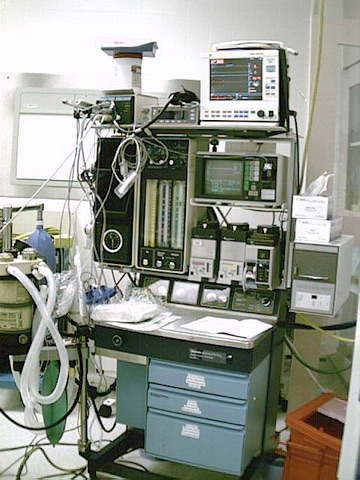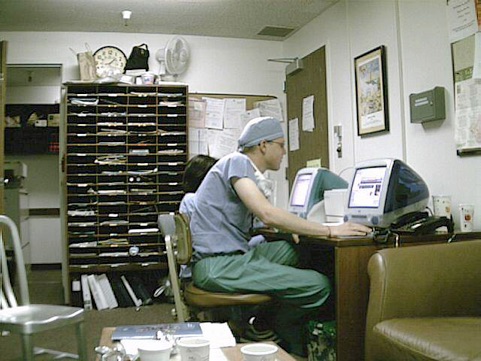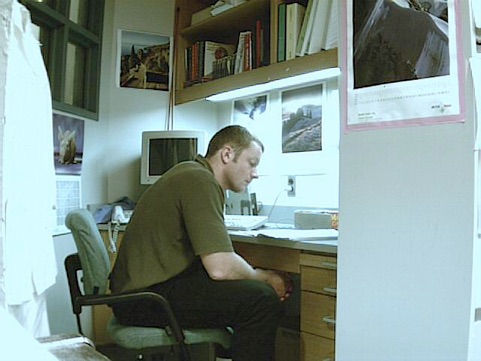First Clinical and Research Work
09 August 2001
Robert arrived safely last Saturday and has been finding his way around San Francisco while I've been at work. He likes the house too, so we'll probably be here for a while (for those of you who visit, there is a guest room). He starts work next Monday at Digitas

I had my first day in the OR on Monday. They think it very funny that I call it a "theatre". Things are not so different from at home, though I was surprised at how old some of the equipment is. The anaesthetic machines are Ohmeda, the monitoring in the OR is Datex (AS/3 and Capnomacs) with HP monitors in the PACU. Every machine also seems to have a spare oximeter taped on for when the Datex one fails.

They don't seem to be at all cost-conscious in the choice of drugs and gas flows, but I hope not to get out of the habit of using the more economical practices learned at St Vincent's and the Royal Childrens. I'm still waiting for the paperwork to be completed so I can be allowed to do any direct patient care, but for the time being I've been with a resident (whom we would call a registrar) who has done the procedural work anyway.
Their handling of narcotic is what I had expected: we have to sign out a locked box of drugs in the morning and all empty ampoules and any syringes containing opiates have to be signed back in to the pharmacy together with documentation of the use of the drugs. What is surprising is that all hypnotics are kept in the locked box, including midazolam, propofol and thiopentone. When I asked about this I was told that it was because they have some potential for abuse but no one seems to consider whether these handling practices actually reduce the potential for abuse.
My first list was an all day one consisting of a lap. adrenalectomy, a thyroidectomy and a parathyroidectomy and today's all-day list was one VATS lung resection (but we did finish early). The surgeons do seem to be a bit slower than at home, but two days is probably not enough to judge it on. Their overall average theatre utilization is only about three cases per theatre per day, but they do a lot of major stuff: two liver transplants today.

The anaesthetic staff have their own tea room, so I don't know where the nurses' or surgeons' tea rooms are. There is Internet access in the tea room (above) and almost all the computers here are Macs. That's Nils, a German medical student, on the blue iMac. He's doing some research on Xenon for cardiac anaesthesia.
My research will be with Pam Palmer's team who are working on the role of nociceptin and the ORL-1 receptor in pain transmission and also just starting some work on opioid tolerance. They have given me a desk in the lab,

and a pile of their recent publications to read. I have been helping a little with some of the rat trials.
< Previous

I had my first day in the OR on Monday. They think it very funny that I call it a "theatre". Things are not so different from at home, though I was surprised at how old some of the equipment is. The anaesthetic machines are Ohmeda, the monitoring in the OR is Datex (AS/3 and Capnomacs) with HP monitors in the PACU. Every machine also seems to have a spare oximeter taped on for when the Datex one fails.

They don't seem to be at all cost-conscious in the choice of drugs and gas flows, but I hope not to get out of the habit of using the more economical practices learned at St Vincent's and the Royal Childrens. I'm still waiting for the paperwork to be completed so I can be allowed to do any direct patient care, but for the time being I've been with a resident (whom we would call a registrar) who has done the procedural work anyway.
Their handling of narcotic is what I had expected: we have to sign out a locked box of drugs in the morning and all empty ampoules and any syringes containing opiates have to be signed back in to the pharmacy together with documentation of the use of the drugs. What is surprising is that all hypnotics are kept in the locked box, including midazolam, propofol and thiopentone. When I asked about this I was told that it was because they have some potential for abuse but no one seems to consider whether these handling practices actually reduce the potential for abuse.
My first list was an all day one consisting of a lap. adrenalectomy, a thyroidectomy and a parathyroidectomy and today's all-day list was one VATS lung resection (but we did finish early). The surgeons do seem to be a bit slower than at home, but two days is probably not enough to judge it on. Their overall average theatre utilization is only about three cases per theatre per day, but they do a lot of major stuff: two liver transplants today.

The anaesthetic staff have their own tea room, so I don't know where the nurses' or surgeons' tea rooms are. There is Internet access in the tea room (above) and almost all the computers here are Macs. That's Nils, a German medical student, on the blue iMac. He's doing some research on Xenon for cardiac anaesthesia.
My research will be with Pam Palmer's team who are working on the role of nociceptin and the ORL-1 receptor in pain transmission and also just starting some work on opioid tolerance. They have given me a desk in the lab,

and a pile of their recent publications to read. I have been helping a little with some of the rat trials.
< Previous
Next >